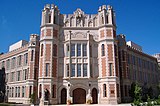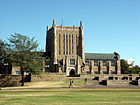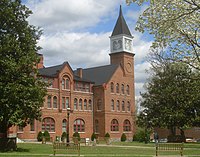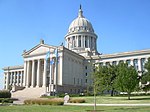Portal:Oklahoma/Selected article
Selected article
The Cherokee are a people from
Of the southeastern Indian confederacies of the late 1600s and early 1700s (Creek, Chickasaw, Choctaw, etc), the Cherokee were one of the most populous and powerful, and were relatively isolated due to their hilly and mountainous homeland. Beginning at about the time of the
Portal:Oklahoma/Selected article/2
Ed Galloway's Totem Pole Park consists of eleven objects and one building on 14 acres (57,000 m²) in Rogers County, Oklahoma. The park is ten miles (16 km) north-east of Claremore and is located 3.5 miles (6 km) east of historic U.S. Route 66 and Foyil. It was added to the National Register of Historic Places on 30 March 1999 and is currently owned and operated by the Rogers County Historical Society and the Foyil Heritage Association. The park's main totem pole is claimed to be the "World’s Largest Concrete Totem Pole."
After more than 20 years as a manual arts teacher at the Children’s HomePortal:Oklahoma/Selected article/3
The Dust Bowl was a series of dust storms causing major ecological and agricultural damage to American and Canadian prairie lands from 1930 to 1936 (in some areas until 1940), caused by severe drought conditions coupled with decades of extensive farming without crop rotation or other techniques that prevented erosion. The fertile soil of the Great Plains was exposed through removal of grass during plowing. During the drought, soil dried out, became dust, and blew away eastwards and southwards, mostly in large black clouds. At times, the clouds blackened the sky all the way to Chicago, and much of the soil was completely deposited into the Atlantic Ocean.
This ecological catastrophe, which began as the economic effects of thePortal:Oklahoma/Selected article/4
The Oklahoma City bombing was a
Just 90 minutes after the explosion, an Oklahoma Highway Patrol officer pulled over 27-year old
The attacks led to the U.S. government passing legislation designed to increase protection around federal buildings and to thwart future terrorist attacks. Under these measures, law enforcement has since foiled over fifty domestic terrorism plots.
On April 19, 2000, the Oklahoma City National Memorial was dedicated on the site of the Murrah Federal Building to commemorate the victims of the bombing. (Read more...)Portal:Oklahoma/Selected article/5
The Comanche are a Native American group whose historical range (the Comancheria) consisted of present-day Eastern New Mexico, Southern Colorado, Southern Kansas, all of Oklahoma, and most of Northern and Southern Texas. There might once have been as many as 20,000 Comanches. Today, the Comanche Nation consists of approximately 10,000 members, about half of whom live in Oklahoma (centered at Lawton), with the remainder concentrated in Texas, California, and New Mexico.
There are various accounts of the origin of the name Comanche. Perhaps the most widely accepted is that it derives from Komantcia, a Spanish corruption of "Kohmahts", thePortal:Oklahoma/Selected article/6
The University of Oklahoma, often called OU or Oklahoma, is a
Portal:Oklahoma/Selected article/8
The Trail of Tears refers to the
Portal:Oklahoma/Selected article/9
The Woody Guthrie Folk Festival is an annually festival held in mid-July to commemorate the life and music of Woody Guthrie. The festival starts on the weekend closest to July 14 - the date of Guthrie's birth - in Guthrie's hometown of Okemah, Oklahoma. Daytime main stage performances are held inside at the Brick Street Cafe and the Crystal Theater. Evening main stage performances are held outdoors at the Pastures of Plenty. The festival is planned and implemented annually by the Woody Guthrie Coalition, a non-profit corporation, whose goal is simply to ensure Guthrie's musical legacy. The event is made possible in part from a grant from the Oklahoma Arts Council. Mary Jo Guthrie Edgmon, Woody Guthrie's younger sister, is the festival's perennial guest of honor.
The festival, which over the years has morphed into being called "WoodyFest" by attendees, was founded in 1998 and the inaugural festival included performances by Guthrie's son Arlo Guthrie, British folk-punk-rock artist Billy Bragg, Ellis Paul, Jimmy LaFave, Joel Rafael, and The Red Dirt Rangers. For the festival's founding, the Woody Guthrie Coalition commissioned a local Creek Indian sculptor to cast a full-body bronze statue of Guthrie and his guitar, complete with the guitar's well-known inscription: "This machine kills fascists". (Read more . . . )Portal:Oklahoma/Selected article/10
The Golden Driller is a 76 foot tall (23 meter), 43,500 pound statue of an oil worker, in Tulsa, Oklahoma, which is claimed to be the "largest free standing statue in the world." It was originally built in
Portal:Oklahoma/Selected article/11
The Arkansas River is a major tributary of the Mississippi River. The Arkansas generally flows to the east and southeast, and traverses the states of Colorado, Kansas, Oklahoma, and Arkansas. At 1,469 miles (2,364 km) it is the sixth longest river in the United States the second-longest tributary in the Mississippi-Missouri system, and the 45th longest river in the world. Its origin is in the Colorado Rockies in Lake County near Leadville, and its outlet is at the historic site of Napoleon, Arkansas. The Arkansas River drainage basin covers nearly 195,000 sq mi (505,000 km²).
At its headwaters the Arkansas runs as a steep mountain torrent through the Rockies in its narrow valley, dropping 4600 feet (1.4 km) in 120 miles (193 km). This section (including The Numbers, Brown's Canyon, and the
Portal:Oklahoma/Selected article/12
The University of Tulsa is a private, comprehensive university awarding bachelor's, master's, and doctoral degrees located in
Portal:Oklahoma/Selected article/13
The Indian Territory served as the destination for the policy of
Portal:Oklahoma/Selected article/14
The Blue Whale of Catoosa is located just east of the town of Catoosa, Oklahoma, and it has become one of the most recognizable attractions on old Route 66.
Hugh Davis built the Blue Whale in the early 1970s as a surprise anniversary gift to his wife Zelta, who collected whale figurines. The Blue Whale and its pond became a favorite swimming hole for both locals and travelers along
Originally, the pond surrounding the massive Blue Whale was spring fed and intended only for family use. However, as many locals began to come to enjoy its cool waters, Davis brought in tons of sand, built picnic tables, hired life guards, and opened his masterpiece to the public.
Originally called Nature’s Acres, Mr. Davis continued to add to the roadside attraction until it eventually included The Fun and Swim Blue Whale and the A.R.K. (Animal Reptile Kingdom). The attraction also featured Hugh’s brother-in-law, Indian Chief Wolf Robe Hunt, a full blooded Acoma Indian, who was famous, in his own right, for his Indian paintings and as a highly skilled silversmith. Chief Wolf-Robe Hunt once ran the Arrowood Trading post across the highway from the Blue Whale attraction. (Read more...)Portal:Oklahoma/Selected article/16
Oklahoma State University, located in
Portal:Oklahoma/Selected article/17
Northeastern State University (NSU) is a public university with its main campus located in
Portal:Oklahoma/Selected article/18
The Oklahoma State Capitol is the house of government of the U.S. state of Oklahoma. It is the building that houses the Oklahoma Legislature, and the meeting place of the Oklahoma Supreme Court. It is located along Lincoln Boulevard in Oklahoma City. The present structure includes a dome that was completed during 2002. The building is a National Historic Landmark.
The state capitol campus is famous for its oil wells and remains the only state capitol grounds in the United States with active oil rigs. The capitol building is directly atop the Oklahoma City Oil Field.
Oklahoma's first capitol was originally located in the city of Guthrie. At noon on April 22, 1889 cannons sounded the start of the
Portal:Oklahoma/Selected article/19
Great Salt Plains Lake is a reservoir located within the Salt Plains National Wildlife Refuge in Alfalfa County, Oklahoma in the United States named because of the salt flats in the area and for the Salt Fork Arkansas River, which is dammed to form the lake.
Created in 1940, the lake, along with Ralstin Island, is home to heron, egret and ibis. Great Salt Plains Lake expands across 8,690 acres (35.2 km2), has 41 miles (66 km) of waterfront and is shallow and salty. The average depth of the lake is only 3 feet (1 m) at normal pool. The sodium content of the lake is approximately 50% that of the ocean. The fish vary from catfish, saugeye, sandbass and hybrid striper.
On the west edge of the lake, visitors can dig for selenite crystals. These crystals feature an hourglass inclusion which is unique to the Great Salt Plains. Scientists believe that salt was deposited during repeated water-level rises of a shallow sea millions of years ago. The supply of salt is kept intact by saline groundwater that flows just a few feet below the surface. When the water evaporates, a layer of salt remains on the surface. This process also plays a role in the formation of selenite crystals that visitors covet. (Read more . . . )Portal:Oklahoma/Selected article/20
Portal:Oklahoma/Selected article/20















